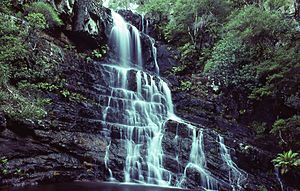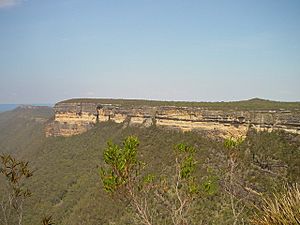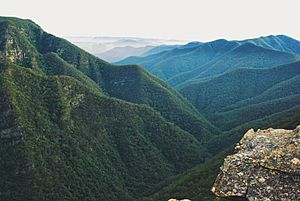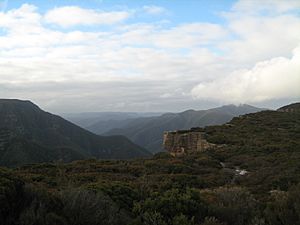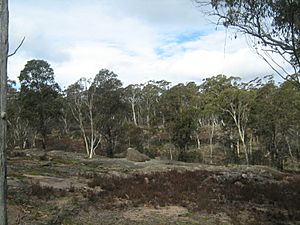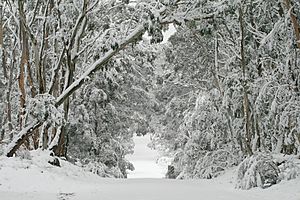Kanangra-Boyd National Park facts for kids
Quick facts for kids Kanangra-Boyd National ParkNew South Wales |
|
|---|---|
|
IUCN Category Ib (Wilderness Area)
|
|

Kanangra Grand Gorge
|
|
| Nearest town or city | Oberon |
| Established | 3 December 1969 |
| Area | 686.6 km2 (265.1 sq mi) |
| Managing authorities | NSW National Parks & Wildlife Service |
| Website | Kanangra-Boyd National Park |
| See also | Protected areas of New South Wales |
The Kanangra-Boyd National Park is a special protected area in New South Wales, eastern Australia. It's located in the Central Tablelands region, about 180 kilometres (110 miles) south-west of Sydney. This huge park covers about 68,660 hectares (170,000 acres). It connects with the Blue Mountains National Park and the Nattai National Park. The park was created in 1969 to protect its amazing nature.
Kanangra-Boyd National Park is super important! In 2000, it became part of the UNESCO World Heritage-listed Greater Blue Mountains Area. This means it's recognized globally for its unique natural beauty. The park is also part of the Great Dividing Range, a long chain of mountains in Australia.
Some of the cool places to see in the park include the Thurat Spires, Kanangra Walls, and Mount Colong. You can also find three beautiful waterfalls: Kalang Falls, the 225-metre (738 ft) high Kanangara Falls, and Morong Falls. The park also has special karst landforms, which are caves and rock formations that experienced cavers can explore. Did you know the movie Jedda was filmed in the Kanangra Walls area in 1954?
Contents
What Makes Kanangra-Boyd National Park Special?
Kanangra-Boyd National Park has two main types of land. There's the high, gently rolling Boyd Plateau, and then there are deep valleys with creeks, rivers, gorges, and ridges. You can reach the plateau by driving on Kanangra Walls Road from Oberon or Jenolan Caves. This road takes you right to the famous Kanangra Walls. Other well-known spots include Mount Cloudmaker and the Thurat Spires. The name Kanangra is thought to come from the Gundangura language.
The park is surrounded by different natural areas. To the north, there's farmland. To the east, you'll find the Coxs River, the Blue Mountains National Park, and the Kowmung River. To the south, it's next to the Nattai National Park. To the west, it borders the Jenolan Karst Conservation Reserve and more farmland. The Abercrombie River National Park is also nearby.
How Was the Park Formed?
The Kanangra-Boyd area is one of the biggest and toughest wilderness spots in New South Wales. It's south of Katoomba and looks very different from the rest of the Blue Mountains. Here, very old rocks, called Palaeozoic rocks, are found on the surface. These rocks include quartzite, diorite, and different types of volcanic and sedimentary rocks.
The Boyd Plateau is made of ancient granite that pushed its way into other rocks. Kanangra Walls is a huge cliff made of Permian rocks. Kanangra Gorge is one of Australia's deepest gorges, cut 600 to 900 metres (2,000 to 3,000 ft) deep into the rocks. Mount Cloudmaker and Guouogang are old parts of quartzite rock that have been worn down over time. The Jenolan River valley has a large limestone area that is 300 metres (980 ft) thick and 8 kilometres (5.0 mi) long. This area has amazing karst features, which are landforms created by water dissolving soluble rocks like limestone.
Plants and Trees in the Park
The park's different rocks, weather, and landscape create many types of plant life. You can find eucalypt forests with trees like yellow box and white box in drier areas. In places with good soil, you'll see mountain ash trees. Where the soil is poor, Blaxland's stringybark grows. Other trees include red spotted gum and forest oak.
If you see limestone, you'll find many Kurrajong trees. In sheltered valleys, there are rainforest plants like red cedar and blue gum. On the Boyd Plateau, you'll find misty mountain forests with trees like brown barrel, messmate, and snow gum. High, windy areas have low bushes and heath plants. Wet areas have swamps with sedges and plants like Leptospermum and Baeckea.
The Blue Mountains area has about 1,000 types of flowering plants. Over 45 rare or endangered plant species live in this wilderness. A special type of tall forest grows in the Kedumba Valley, with the Camden white gum, which is an endangered species found only in these areas.
Animals in the Park
The Blue Mountains National Park is home to many animals! It has 46 types of mammals, including 27 marsupials (like kangaroos and koalas) and two monotremes (like echidnas). More than 200 types of birds and 98 types of reptiles have been seen here.
Several important and protected animals live in the wilderness area. These include:
- The powerful owl (Ninox strenua)
- The squirrel glider (Petaurus norfolcensis)
- The yellow-bellied glider (Petaurus volans)
- The tiger quoll (Dasyurus maculatus)
- The brush-tailed rock wallaby (Petrogale penicillata)
A special type of velvet worm called Euperipatoides kanangrensis has also been found on the Boyd Plateau.
Exploring the Park: Bushwalking Trails
Kanangra-Boyd National Park has several walking tracks and places to visit:
- Lookout Walk: This is an easy, ten-minute walk that is even good for wheelchairs. It leads to two lookouts. The first lookout gives you amazing views of the Kanangra Creek gorges and the high tops of Mt Cloudmaker. The second lookout shows rugged ravines and Kanangra Falls.
- Waterfall Walk: You can get to this walk from the Lookout Walk. It goes down into a gully where the Kalang Falls splash into a pool.
- Plateau Walk: This walk turns off before the main lookout and takes you into the Kanangra Wilderness. It leads onto the wide, heath-covered Kanangra Tops Plateau. You can even walk from here all the way to Katoomba and Narrow Neck if you're up for a long adventure!
If you want to stay overnight, camping is available at the Boyd River campground, which is located on Kanangra Road, near Morong Creek.
See also
 In Spanish: Parque nacional Kanangra-Boyd para niños
In Spanish: Parque nacional Kanangra-Boyd para niños



